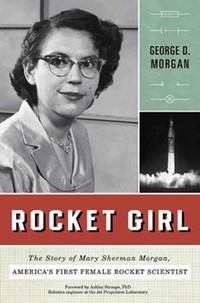Review: Rocket Girlby Jeff Foust
|
| It was hydyne and LOX that powered the converted Jupiter-C rocket that launched Explorer 1 into the history books. Why, then, did hydyne not also launch Mary Sherman Morgan into the history books? |
Not every female aerospace pioneer, though, is as famous as Ride or Tereshkova. Take, as one example, Mary Sherman Morgan. Billed in the subtitle of George Morgan’s biography as “America’s first female rocket scientist,” she played a key role in the successful launch of America’s first satellite, Explorer 1, in 1958. Her contribution, though, had been forgotten until after her death, when George Morgan, her eldest son, was inspired to find out the role she played in the early days of America’s space program.
Although George Morgan doesn’t verify the claim in the subtitle of Rocket Girl that his mother was the first female rocket scientist in the US, she was the first woman hired in a technical position at North American Aviation in the late 1940s, her aptitude for chemistry and work as a chemist at Plum Brook Ordnance Works during World War II overcoming her lack of a college degree and her gender at a time when qualified job applicants were in short supply. She developed a reputation as an expert in developing propellant combinations for rockets and missiles, and eventually was given a critical problem: develop an alternative to the alcohol and liquid oxygen (LOX) propellants used on the Jupiter rocket that would improve its performance enough to allow it to launch a satellite.
While her supervisors directed her to look at different oxidizers, she instead focused her attention on replacing the alcohol fuel with alternatives that would increase the rocket’s performance without requiring major changes to its engine or propellant tanks. Working with a few colleagues, she came up with a blend of 60% unsymmetrical dimethylhydrazine (UDMH) and 40% diethylenetriamine (DETA). She suggested this alternative fuel be called, oddly enough, “bagel” (as in bagel and LOX), but the company instead chose the name hydyne. And it was hydyne and LOX that powered the converted Jupiter-C rocket that launched Explorer 1 into the history books.
Why, then, did hydyne not also launch Mary Sherman Morgan into the history books? Her contribution, it appears, got no publicity at the time, but then, few individuals other than people like Wernher von Braun got much attention at the time. She also left North American not long after that success, deciding to become a stay-at-home mother. Hydyne itself was also something of a dead end: while it solved a specific problem, the noxious combination of UDMH and DETA was less desirable in the long run to higher performing and/or less toxic fuels like kerosene and liquid hydrogen.
| Rocket Girl is an interesting book that sheds light on a little-known person who played a key role in the early days of the space age, one that should be more prominent given how few women were involved in aerospace at the time. |
And, as George Morgan found, she did little to keep records or discuss her life with even her immediate family. She never talked about her work, even when he took up an interest in amateur rocketry as an adult. She also never showed much affection for her children, he recalls, staying at home playing cards all day (he speculates that she may have suffered from a form of obsessive-compulsive disorder.) He didn’t find out her role in developing hydyne until speaking with her former coworkers at her 2004 funeral. He was inspired to research and write about her life (including not just this book but also a play by the same name in 2008) when the Los Angeles Times rejected his obituary of her, claiming it was unable to verify the facts it contained about her career.
Rocket Girl is not a traditional biography that follows an individual’s life in a steady chronological arc. Instead, George Morgan skips around in time and space, interweaving her life with that of von Braun and even Soviet rocketry pioneer Sergei Korolev, as well as his own experiences growing up and, later, trying to find out about his mother’s life. The book is written in a style he calls “creative nonfiction,” a concept that sounds like an oxymoron but, he writes, is necessary to make a readable story when information is limited. That includes inventing dialogue between individuals in conversations that appear frequently in the book; the facts behind those conversations are accurate, although the specific conversations are the “creative” part of “creative nonfiction.” (George Morgan discusses the use of creative nonfiction in an author’s note at the end of the book; it may have been better to place it at the front of the book to explain any questions by readers about his ability to reproduce, word-for-word, discussions that took place decades ago.)
Use of creative license aside, Rocket Girl is an interesting book that sheds light on a little-known person who played a key role in the early days of the space age, one that should be more prominent given how few women were involved in aerospace at the time. (A foreword by Ashley Stroupe, a JPL engineer who has worked on Mars rover missions, helps contrast the attitudes Mary Sherman Morgan faced with the more welcoming attitudes of today.) However, the reader will finish this book with many unanswered questions about her life, something that is not a failing of the author but instead a limitation of what she wanted known about her life. “This is a story of a woman who harbored many secrets and lived in daily fear that those secrets would one day be revealed,” her son writes in the book’s opening chapter. “This is the story of a woman who took those secrets to her grave.”
